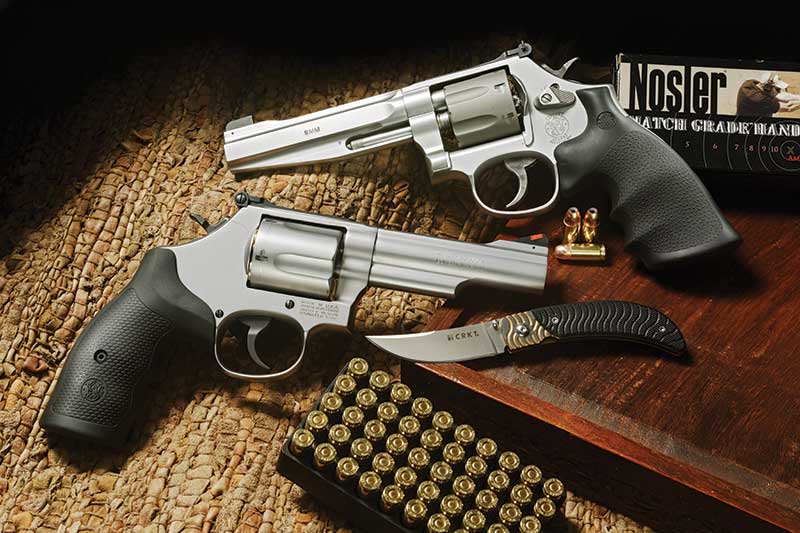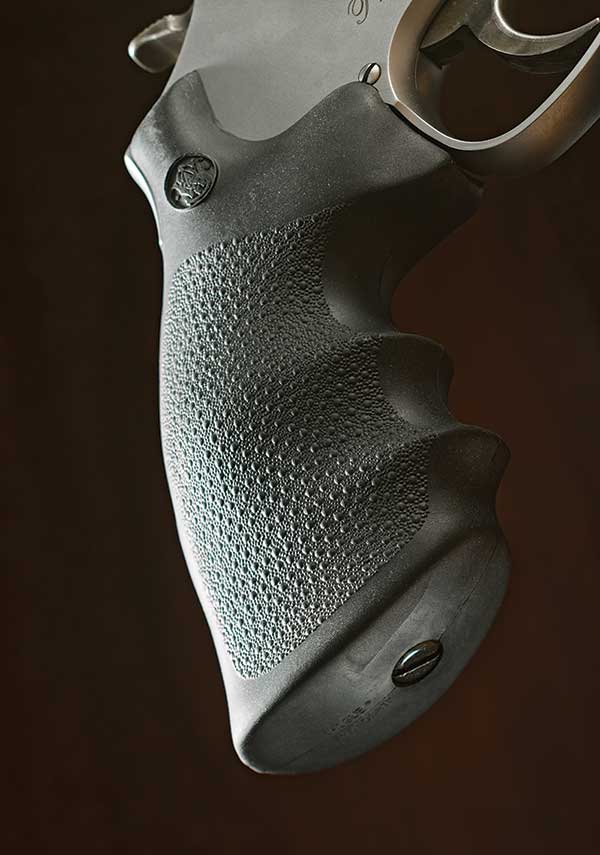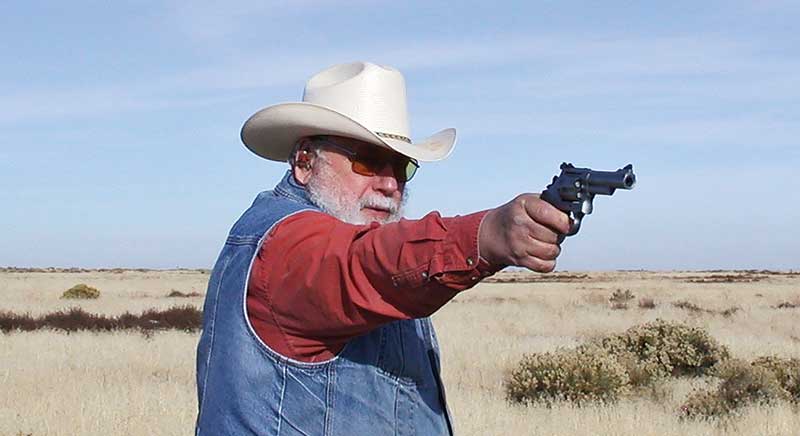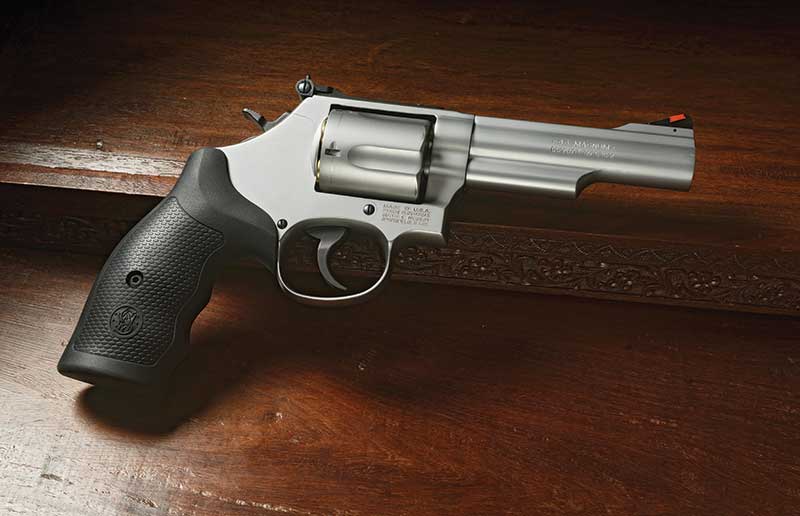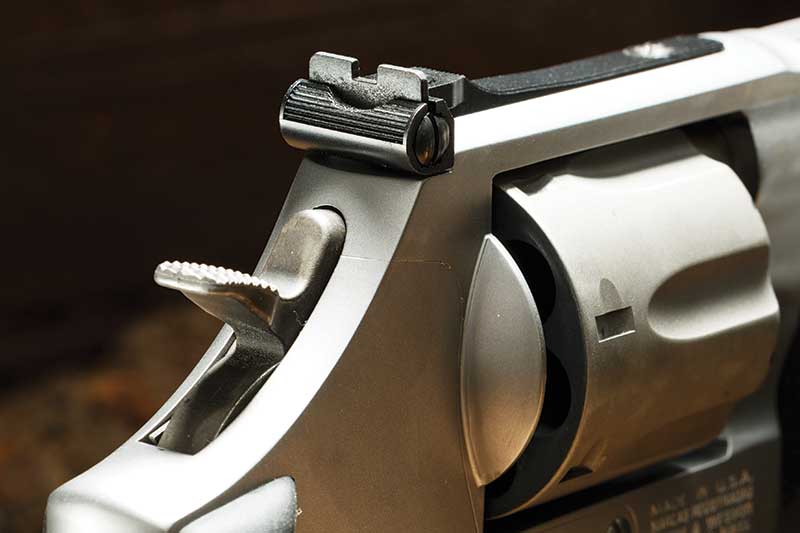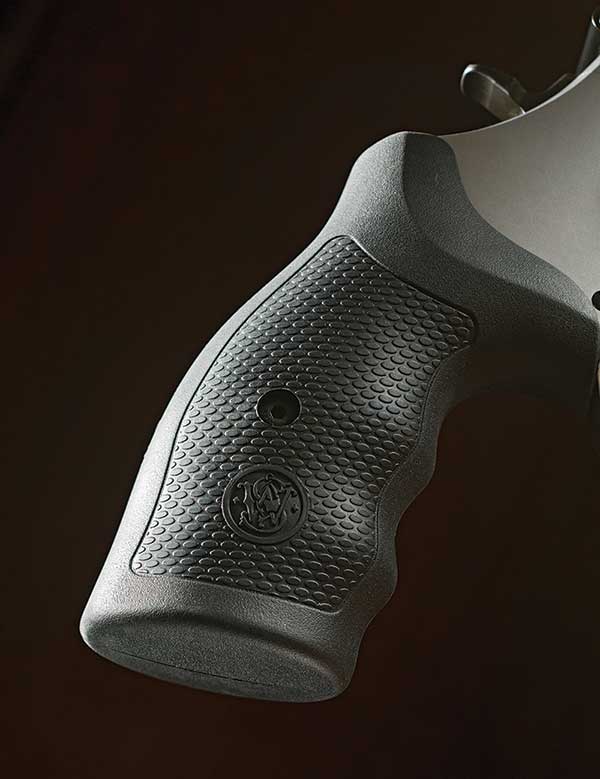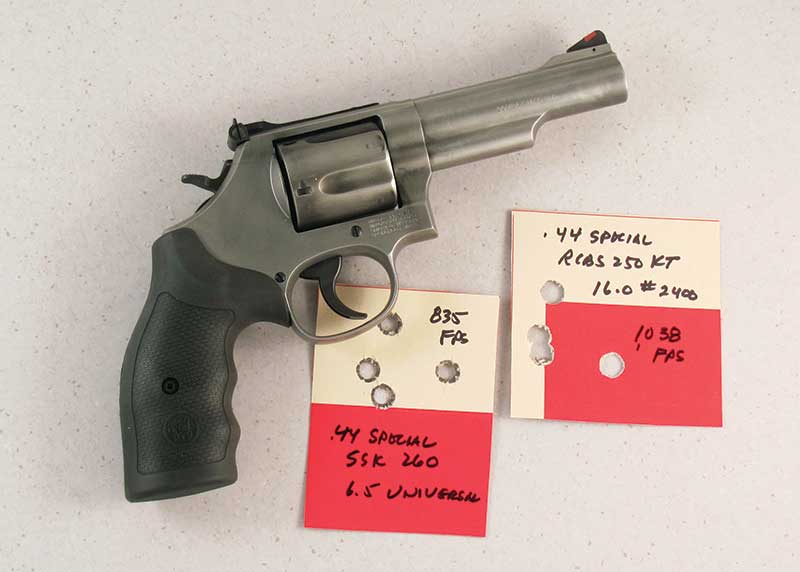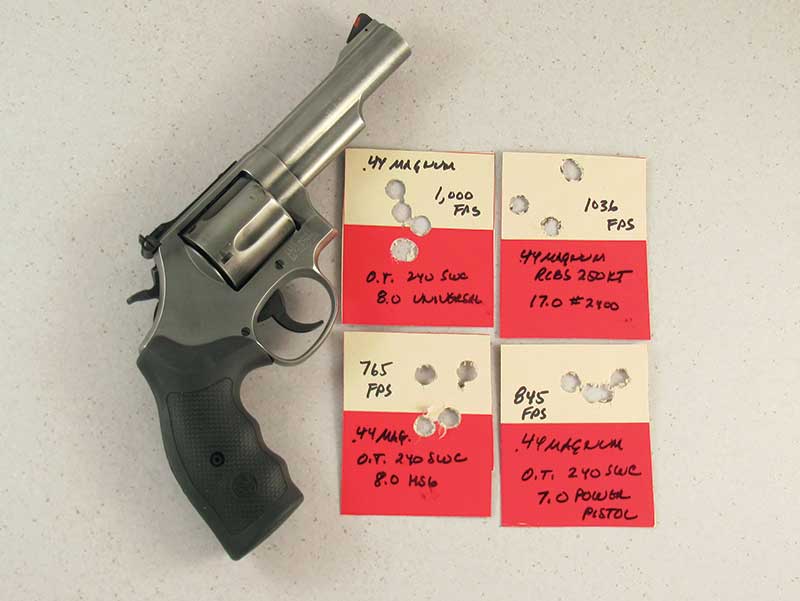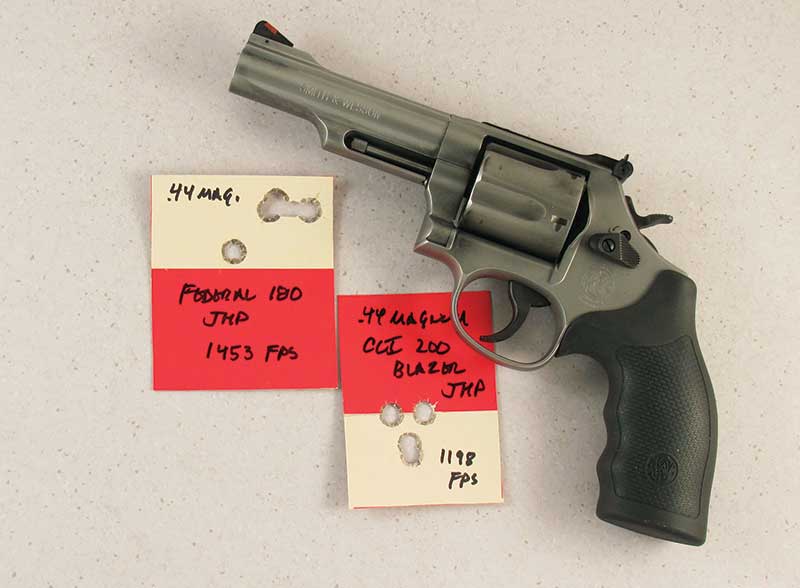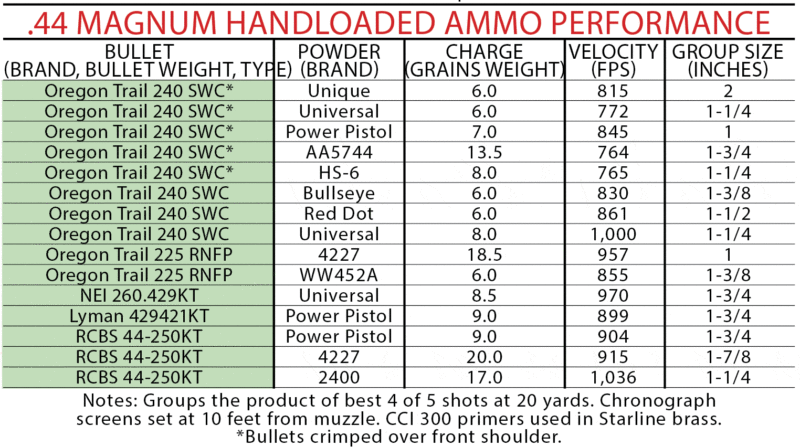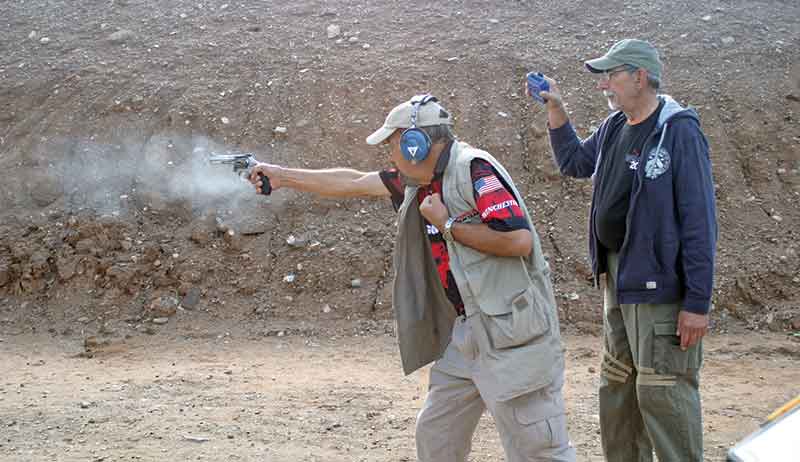The double-action trigger pull was a reasonably smooth 14 pounds. Heavy is necessary here, because springy moon clips create headspace and ignition issues, requiring a hard smack of the hammer. The single-action pull weight was a bit over 4 pounds and very crisp.
As with the N-Frame 929 9mm 8-shooter, you can’t just drop rimless cartridges into a 986’s chambers and fire away, punching the empties out with a pencil or plucking them out with a fingernail. We hand-fed 7 rounds into the 986’s chambers, stroked the trigger seven times, and got seven clicks with no “bangs.” The firing pin barely touched a couple of primers and never touched most. Obviously, moon clips are necessary with the 986.
To find out how the 9mm would handle the jump from a revolver’s firing chamber to the forcing cone, across the velocity-bleeding barrel/cylinder we ran four of our accuracy-testing loads over an Oehler chronograph (see chart). For a good home defense load, I chose 115-grain Federal 9BPLE, a +P+ jacketed hollowpoint. Although my 5-shot group measured 3.30, with the best three in 1.65 inches. This load pretty much “shot to the sights,” point-of-aim vis-à-vis point of impact.
Hunting with a 9mm revolver does not seem to compute, but if it’s all you’ve got, it’s better than a sharp stick. For dangerous game, we’d want something like the Buffalo Bore 124-grain Penetrator round, loaded to +P+ pressure with a solidly jacketed flatnose bullet which the 986 grouped slightly above the other loads, but right to point-of-aim. Ejection was sticky, and we had to hammer the ejector rod to get the spent moon clips out. Probably not the best load for our test sample.
Happy 35th Anniversary
S&W L-Frame!
9x7= A Different Spin.
S&W’s Pro Series Model 986
Is An Upscale Take On The
9mm Revolver Concept
Introduced in 2014, the Pro Series 986 L-Frame is very much a niche gun, but it actually fills more niches than you may think. In the Open Class of ICORE action revolver shooting, many would prefer the 8-shot moon clips of the bigger N-frame version of this gun, the 929. However, weighing about the same as a 4-inch K-Frame .357 Combat Magnum and fitted with a 5-inch barrel, the 986 seems to track faster between targets. For some, that’s worth losing a shot for.
Some folks just don’t trust autos and cleave to the revolver for personal defense, but appreciate the relatively low price of 9mm practice ammo. Because a moon clip is generally faster than a speedloader, a 9mm revolver comes into its own in a crisis. And of course, there’s the very mild recoil of the 9mm in a relatively hefty L-Frame.
One reason some of us cherish our .45 ACP S&W revolvers is that every now and then, our reload recipes for our .45 autos come out too short or too light in the powder charge to cycle our square guns. So our revolvers make a handy garbage disposal for those reloads (and it’s a lot more fun than disassembling ammo). The same will be true for 9mm revolver/auto owners.
My friend Roger Clark has made his Bill Pfeil-tuned 986 his daily carry gun in a hip holster made by a local craftsman. Roger is tall, so he conceals the gun well and appreciates its light recoil, fast reloading, excellent handling and reliability.
It’s subjective, but I love the S&W Performance Center’s signature barrel style on this gun. Gracefully tapered, it pleases both the eye and the hand with exquisite balance and fast handling. The light titanium alloy cylinder is a help here. And given the range of 9mm loads, its standard S&W adjustable sight is almost a necessity.
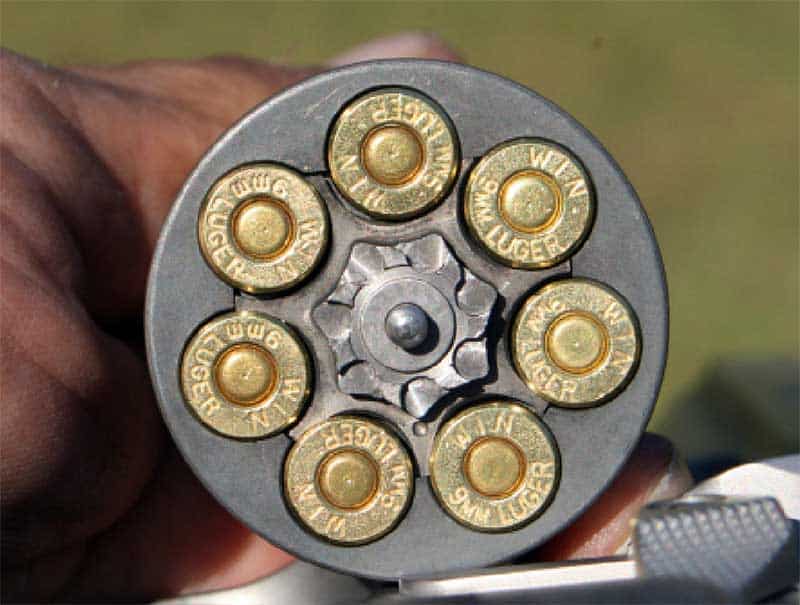
This ain’t your daddy’s auto-caliber revolver. Without moon clips, cartridges seat to different levels in the chambers
(above). Don’t shoot the 986 without moon clips! Seven pulls of the trigger later, none of the rounds chambered
without moon clip fired, some were untouched and some only very slightly dented by firing pin. Remington-UMC
147-grain 9mm ammo gave this fine 5-shot group (below) at 25 yards from the 986.
As the test approached deadline, we received two flavors of Nosler’s excellent Match Grade ammo, both JHP’s. We did not have time to chronograph them, but the 115-grain was factory spec’d for a sedate 1,170 fps, while the 124 is loaded to a nominal 1,200 fps. With the 115-grain load we got 3.45-inch groups (best three in 1.95). The 124 grain gave us 2.65 (best three in 1.05).
Back in the 1970’s, I debriefed Illinois Trooper Ken Kaas, whose department was the only state police agency issuing semi-auto’s instead of 6-shot revolvers at the time. He got into a gunfight with a bad guy who opened fire on him with a semi-automatic shotgun from behind hard cover, and was smart enough to keep track of his opponent’s shots. As Kaas fired his sixth round, the gunman jumped up and rushed toward Kaas, who promptly dropped him with a bullet through the liver. Later, in custody at a hospital, his attacker was heard to tell his lawyer, “He (the trooper) fired all six!” April Fools! Trooper Kaas had a seventh round waiting in his issue S&W Model 39.
I shot the late, lamented Second Chance bowling pin match from the mid-1970’s until the last one in the late ’90’s. I lost count of how many revolver shooters had left one pin standing after their six shots were expended, and had to take time to reload or go to another gun, when one more shot would have stopped the stopwatches and allowed them to clear the table with a prize-winning time. And at Bianchi Cup, I saw one LAPD pistol team member who was in the lead lose the title when he short-stroked his S&W .38 Special on one shot, and didn’t have time to run through the cylinder again before the moving target disappeared behind its impenetrable barricade.
So, yes, my revolver brothers, the 7th shot does bring value to the table.
By Massad Ayoob
The Perfect Packin’ Pistol is the Smith & Wesson’s Model 69 .44 Magnum
Over the past 35 years Smith & Wesson has mostly offered L-Frame sixguns in .357 Magnum and, most notably, a 5-shot .44 Special including the Model 696 and the Mountain Light Model 396. Now Smith & Wesson has introduced the L-Frame M69 revolver, which to my way of thinking is just about the most Perfect Packin’ Pistol double-action style ever offered by Smith & Wesson.
A Perfect Packin’ Pistol was defined by yours truly too many years ago as an easy carrying sixgun, either double or single action, with a barrel length of 4 to 5-1/2 inches, and chambered in a cartridge which would handle anything likely to be encountered. Of course, the chambering would depend upon where the PPP was being carried and could be anything from .22 Long Rifle up to one of the really big-bore magnums.
Smith & Wesson has reach the epitome of Perfect Packin’ Pistols with the Model 69 Combat Magnum chambered in .44 Magnum. This is a stainless steel, 5-shot, 4-1/4-inch double-action sixgun. Sights are typical S&W adjustables with a white outline rear sight matched up with a red ramp front sight. The frame screws, hammer, trigger and cylinder release as well as the front and rear sight are matte black finish and contrast nicely with the matte stainless steel of the rest of this excellent big-bore revolver.
The front of the cylinder is chamfered for easy entrance into a holster and the muzzle has a deep concave crown, which protects the rifling. The right side of the barrel is marked in two lines with “.44 Magnum” and “Combat Magnum.” The grips are wrap around fingergroove-style, pebble-grained rubber. Single-action trigger pull is 4-1/4 pounds while the double action measures 14 pounds. The cylinder locks at the front of the frame with a modernized version of the Triple-Lock set up instead of locking at the front of the ejector rod. Since this is a 5-shot .44 Magnum the locking bolt notches on the cylinder are in between chambers so there is no weak spot on each chamber.
Smith & Wesson has reach the epitome of Perfect Packin’ Pistols with the Model 69 Combat Magnum chambered in .44 Magnum. This is a stainless steel, 5-shot, 4-1/4-inch double-action sixgun. Sights are typical S&W adjustables with a white outline rear sight matched up with a red ramp front sight. The frame screws, hammer, trigger and cylinder release as well as the front and rear sight are matte black finish and contrast nicely with the matte stainless steel of the rest of this excellent big-bore revolver.
The front of the cylinder is chamfered for easy entrance into a holster and the muzzle has a deep concave crown, which protects the rifling. The right side of the barrel is marked in two lines with “.44 Magnum” and “Combat Magnum.” The grips are wrap around fingergroove-style, pebble-grained rubber. Single-action trigger pull is 4-1/4 pounds while the double action measures 14 pounds. The cylinder locks at the front of the frame with a modernized version of the Triple-Lock set up instead of locking at the front of the ejector rod. Since this is a 5-shot .44 Magnum the locking bolt notches on the cylinder are in between chambers so there is no weak spot on each chamber.
Test firing of this .44 Combat Magnum began with .44 Special loads with muzzle velocities in the 800 to 1,000 fps neighborhood. Results were most gratifying and especially so because of the fact my utility loads assembled with 7.5 grains of Unique under the Oregon Trail 240-grain SWC delivered 900+ fps and grouped into just over 1 inch. I then switched to .44 Magnum handloads using 15 different loads with muzzle velocities in the same range as my .44 Special loads. Results also were quite gratifying with many loads in the 1-inch category. My .44 Magnum utility load also using the Oregon Trail 240-grain SWC this time over 8.0 grains of Universal clocked out at 1,000 fps and grouped just as did the .44 Special load. I got the same results with the RCBS 44-250KT bullet over 17.0 grains of 2400. For everyday use any of these loads will handle 99 percent of my needs.
I put it off long enough. Now it was time to try .44 Magnum loads. I was not looking forward to shooting full-house loads in this relatively lightweight pistol, however the grip proved to be exceptionally capable of reducing felt recoil. Normally, I prefer to fit custom grips to any of my sixguns, however these factory grips are about as perfect as one is likely to find for handling recoil of the .44 Magnum.
Six different .44 Magnum factory loads were put through the S&W .44 Combat Magnum with all loads shooting right into the 1-inch category or less. These loads consisted of everything from Federal 180-grain JHP’s at 1,450+ fps to Garrett Cartridges of Texas 310-grain Hard Cast Hammerheads at just under 1,000 fps. This load is especially designed for use in 4-inch sixguns providing maximum penetration against critters—most notably bears—which can scratch, claw and bite.
My most used hunting .44 Magnum load over the last couple decades has been the Black Hills 240-grain JHP load using Hornady XTP’s. I’ve taken 24 Texas whitetails and an Idaho cougar all with 1-shot kills using this load. In the Model 69 Combat Magnum it delivered just over 1,100 fps and groups of 1-inch. This was my first time to try HPR ammunition and their 240-grain JHP shot exceptionally well at just over 1,200 fps and a group under 1-inch. The most accurate load proved to be the CCI Blazer 200-grain JHP at 1,200 fps and a 3/4-inch group. What all this shows is the amazing versatility of this 5-shooter with the ability to shoot everything well from lightweight to heavyweight bullets and from jacketed to hard cast.
My first Smith & Wesson .44 Magnum dates back to the early 1960’s when I purchased a 4- and a 6-1/2-inch Model 29. Over the years I have added several more including examples of pre-29’s and they are some of my most prized sixguns. This latest Perfect Packin’ Pistol Smith & Wesson .44 Magnum has also become an instant favorite. It looks great and shoots great. Nearly everything about it is just right. No wide hammer and trigger to get in the way of a real working sixgun and the trigger face is smooth for easy double-action shooting.
The red ramp front sight insert is a bother to my eyes in bright sunlight but this is a subjective problem easily cured. I can use it with everything from standard 750 fps .44 Special loads up to full house Magnum loads and it shoots accurately and handles well. I would call it the most useful .44 Magnum Smith & Wesson has produced since the original .44 Magnum Model 29 disappeared in the waning years of the last century. I like it.
By John Taffin
S&W 686 Memories
1980: The sea change to autos was still just over the horizon, and the big thing in police service revolvers was the switch from .38 Special to .357 Magnum, with full Mag loads in training. The latter was more than the K-Frame Combat Magnum was designed for, and S&W introduced the 586 (chrome-molybdenum steel in blue or nickel) and its stainless twin, the 686 on a “.41-size” L-Frame. Dimensions including weight almost exactly duplicated the Colt Python, but at a much lower price. The 686 was an instant hit, and remains one of Smith & Wesson’s best-selling revolvers to this day.
I liked it, but already having Pythons didn’t own one until Andy Cannon and I collaborated on his “Street-L,” with enhanced action and an integral expansion chamber recoil compensator he machined out of the S&W barrel itself, which only slightly reduced velocity but hugely reduced Magnum recoil and muzzle jump. I carried it on duty sometimes, and one year fitted it with Jarvis barrel weight and Pro-Point red dot optic, and shot it at Bianchi Cup.
Over the years I acquired a 2.5-inch 686 (ideal for PPC “snubby” events) and a 6-inch Mag-na-Port Custom 686-Plus 7-shooter I won at Second Chance. However, the one I’ve spent most time with is a 4-inch stock configuration with shaved cylinder latch, bobbed hammer, and superb action job by Bob Lloyd. It was the gun I used when I shot Stock Service Revolver at the IDPA World Championships, and it won a few state and regional IDPA championships for me. For roughly 3-1/2 decades, the Smith & Wesson Model 686 .357 Magnum has served me well, and I’m one of the many who consider it a modern classic.
By Massad Ayoob
First Encounters With The L-Frame
More than 25 years ago I was assigned a comprehensive article on the history and use of the .357 Magnum. I already had several .357’s including the K-Frame Model 19 Combat Magnum and the Model 27 N-Frame. The assignment gave me an excuse to add the newest Smith & Wesson .357 Magnum at the time, the L-Frame. The Model 19 when fully loaded was nearly 1/2-pound lighter than the Model 27 and was also less bulky. However, by the 1980’s, some Combat Magnum Model 19 shooters as well as those using its stainless steel counterpart, the Model 66, were complaining the K-Frame would not hold up to modern ammunition.
Border Patrol Inspector Bill Jordan originally devised the K-Frame Magnum as one to be practiced with using .38 Specials and fed .357’s for serious business. When shooters started pushing thousands of rounds of Magnum ammunition through the 19/66 some problems developed with forcing cone wear and guns shooting loose. Since the vast majority of my loads for my Model 19 had been assembled with cast bullets I had not experienced any of these problems. Nevertheless I ordered a blue 4-inch L-Frame Model 586 which was known as the Distinguished Combat Magnum. I found it weighed just 1-ounce less than the original Model 27, however, the weight was in the heavy underlug barrel and increased size at the forcing cone.
Shortly after receiving my L-Frame I was invited to take part in the qualification course with the local Sheriff’s Department. At the time the duty weapon was the 4-inch Model 586 equipped with target stocks. I soon discovered several women deputies were having a difficult time with the Model 586 because the grip was much too large for their hands. I was able to show them what could be done by either slimming down the factory grips or fitting their revolver with much smaller custom grips which fit their hands. It made a huge difference in their ability to shoot well. Currently my L-Frame .357 consists of a nickel-plated 6-inch Model 586 which handles any .357 load with ease, while my original 4-inch Model 586 has been converted to .41 Special.
By John Taffin
Model 986 ( Left Gun )
Maker: S&W
2100 Roosevelt Ave.
Springfield, MA 01104
(800) 831-0852
www.smith-wesson.com
Action: Double-action revolver
Caliber: 9mm Parabellum
Capacity: 7
Barrel length: 5 inches
Overall length: 10.5 inches
Sights: Fully adjustable rear
Patridge front, Weight: 34.9 ounces
Grips: Synthetic
Material: Stainless steel frame, titanium alloy cylinder
Price: $1,149
Model 69 ( Right Gun )
Combat Magnum
Maker: S&W
2100 Roosevelt Avenue
Springfield, MA 01104
(800) 331-0852
www.smith-wesson.com
Action Type: Double action
Caliber: .44 Magnum
Capacity: 5
Barrel Length: 4-1/4 inches
Overall Length: 9-3/4 inches
Weight: 37 ounces
Finish: Stainless steel
Sights: White outline adjustable rear, red ramp front
Grips: Finger-groove rubber
Price: $849
